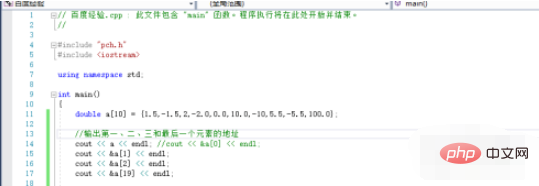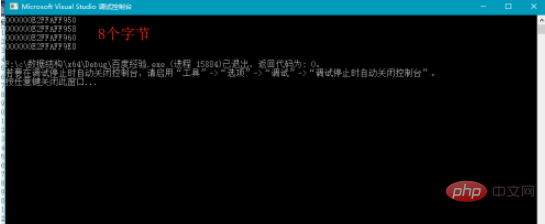How are arrays in C language allocated in memory?
The method of allocating C language arrays in memory: First, the corresponding header file is the iostream stream responsible for input and output; then create an array in the main function, and use the cout statement to output the location of each element in the memory. Address; finally click the Run button to compile, link, and generate an executable file.

How to allocate C language arrays in memory:
1. First, we open the C language compiler, You can choose software such as Visual Studio, Code::Blocks or Dev-C. Here is Visual Studio as an example. Wait for the entire program to be completely loaded into the memory

2. Due to VS It is managed through solutions, so first create a new solution. If there is an existing solution, you can continue to use it, and then create a new project. Since we are debugging a command line program, we need to select the Windows console here. Application

3. After ensuring that the project name is correct, click the OK button. You will see that we have successfully created a project, and then right-click in the project list to add A C file, as shown in the figure after adding it

4. First, we include the corresponding header file, which is the iostream stream responsible for input and output, and set the default The namespace is std

5. Then in the main function, create an array. Here we take a double-precision array as an example. The length is 10 and assign initial values to it. , since the array name identifies the address of the head pointer, if you do not use the array name, you need to use the pointer form to create other types of variables.

6. Then we use cout The statement outputs the address of each element in the memory respectively. Note that you need to add the address & operator. If you are using C language, you can use the printf function to output

7. Confirm After the code is correct, click the run button to compile, link, and generate an executable file. After a moment, we see that the output result is a hexadecimal address value. The address of each two consecutive array elements differs by 8, which means that it is in 64 Each double type data is stored in 8 bytes on the Win10 platform.

##Related learning recommendations:
The above is the detailed content of How are arrays in C language allocated in memory?. For more information, please follow other related articles on the PHP Chinese website!

Hot AI Tools

Undresser.AI Undress
AI-powered app for creating realistic nude photos

AI Clothes Remover
Online AI tool for removing clothes from photos.

Undress AI Tool
Undress images for free

Clothoff.io
AI clothes remover

AI Hentai Generator
Generate AI Hentai for free.

Hot Article

Hot Tools

Notepad++7.3.1
Easy-to-use and free code editor

SublimeText3 Chinese version
Chinese version, very easy to use

Zend Studio 13.0.1
Powerful PHP integrated development environment

Dreamweaver CS6
Visual web development tools

SublimeText3 Mac version
God-level code editing software (SublimeText3)

Hot Topics
 1378
1378
 52
52
 The Art of PHP Array Deep Copy: Using Different Methods to Achieve a Perfect Copy
May 01, 2024 pm 12:30 PM
The Art of PHP Array Deep Copy: Using Different Methods to Achieve a Perfect Copy
May 01, 2024 pm 12:30 PM
Methods for deep copying arrays in PHP include: JSON encoding and decoding using json_decode and json_encode. Use array_map and clone to make deep copies of keys and values. Use serialize and unserialize for serialization and deserialization.
 PHP array key value flipping: Comparative performance analysis of different methods
May 03, 2024 pm 09:03 PM
PHP array key value flipping: Comparative performance analysis of different methods
May 03, 2024 pm 09:03 PM
The performance comparison of PHP array key value flipping methods shows that the array_flip() function performs better than the for loop in large arrays (more than 1 million elements) and takes less time. The for loop method of manually flipping key values takes a relatively long time.
 Application of PHP array grouping function in data sorting
May 04, 2024 pm 01:03 PM
Application of PHP array grouping function in data sorting
May 04, 2024 pm 01:03 PM
PHP's array_group_by function can group elements in an array based on keys or closure functions, returning an associative array where the key is the group name and the value is an array of elements belonging to the group.
 Best Practices for Deep Copying PHP Arrays: Discover Efficient Methods
Apr 30, 2024 pm 03:42 PM
Best Practices for Deep Copying PHP Arrays: Discover Efficient Methods
Apr 30, 2024 pm 03:42 PM
The best practice for performing an array deep copy in PHP is to use json_decode(json_encode($arr)) to convert the array to a JSON string and then convert it back to an array. Use unserialize(serialize($arr)) to serialize the array to a string and then deserialize it to a new array. Use the RecursiveIteratorIterator to recursively traverse multidimensional arrays.
 PHP array multi-dimensional sorting practice: from simple to complex scenarios
Apr 29, 2024 pm 09:12 PM
PHP array multi-dimensional sorting practice: from simple to complex scenarios
Apr 29, 2024 pm 09:12 PM
Multidimensional array sorting can be divided into single column sorting and nested sorting. Single column sorting can use the array_multisort() function to sort by columns; nested sorting requires a recursive function to traverse the array and sort it. Practical cases include sorting by product name and compound sorting by sales volume and price.
 The role of PHP array grouping function in finding duplicate elements
May 05, 2024 am 09:21 AM
The role of PHP array grouping function in finding duplicate elements
May 05, 2024 am 09:21 AM
PHP's array_group() function can be used to group an array by a specified key to find duplicate elements. This function works through the following steps: Use key_callback to specify the grouping key. Optionally use value_callback to determine grouping values. Count grouped elements and identify duplicates. Therefore, the array_group() function is very useful for finding and processing duplicate elements.
 Can arrays be used as function parameters?
Jun 04, 2024 pm 04:30 PM
Can arrays be used as function parameters?
Jun 04, 2024 pm 04:30 PM
Yes, in many programming languages, arrays can be used as function parameters, and the function will perform operations on the data stored in it. For example, the printArray function in C++ can print the elements in an array, while the printArray function in Python can traverse the array and print its elements. Modifications made to the array by these functions are also reflected in the original array in the calling function.
 Exploring the complexity of PHP array deduplication algorithms
Apr 28, 2024 pm 05:54 PM
Exploring the complexity of PHP array deduplication algorithms
Apr 28, 2024 pm 05:54 PM
Complexity of PHP array deduplication algorithm: array_unique(): O(n) array_flip()+array_keys(): O(n) foreach loop: O(n^2)




